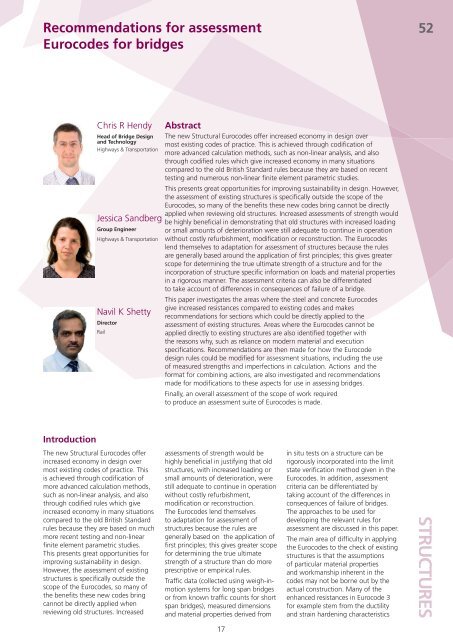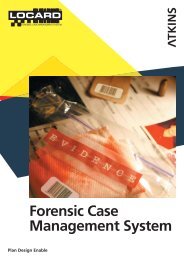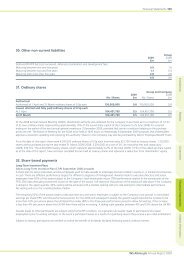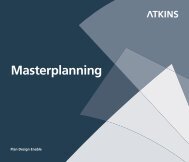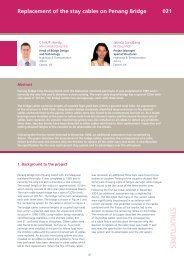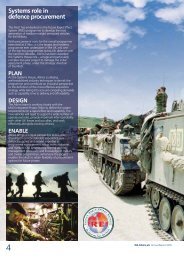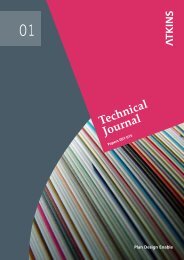001 - TOC.indd - Atkins
001 - TOC.indd - Atkins
001 - TOC.indd - Atkins
Create successful ePaper yourself
Turn your PDF publications into a flip-book with our unique Google optimized e-Paper software.
Recommendations for assessmentEurocodes for bridges52Chris R HendyHead of Bridge Designand TechnologyHighways & TransportationJessica SandbergGroup EngineerHighways & TransportationNavil K ShettyDirectorRailAbstractThe new Structural Eurocodes offer increased economy in design overmost existing codes of practice. This is achieved through codification ofmore advanced calculation methods, such as non-linear analysis, and alsothrough codified rules which give increased economy in many situationscompared to the old British Standard rules because they are based on recenttesting and numerous non-linear finite element parametric studies.This presents great opportunities for improving sustainability in design. However,the assessment of existing structures is specifically outside the scope of theEurocodes, so many of the benefits these new codes bring cannot be directlyapplied when reviewing old structures. Increased assessments of strength wouldbe highly beneficial in demonstrating that old structures with increased loadingor small amounts of deterioration were still adequate to continue in operationwithout costly refurbishment, modification or reconstruction. The Eurocodeslend themselves to adaptation for assessment of structures because the rulesare generally based around the application of first principles; this gives greaterscope for determining the true ultimate strength of a structure and for theincorporation of structure specific information on loads and material propertiesin a rigorous manner. The assessment criteria can also be differentiatedto take account of differences in consequences of failure of a bridge.This paper investigates the areas where the steel and concrete Eurocodesgive increased resistances compared to existing codes and makesrecommendations for sections which could be directly applied to theassessment of existing structures. Areas where the Eurocodes cannot beapplied directly to existing structures are also identified together withthe reasons why, such as reliance on modern material and executionspecifications. Recommendations are then made for how the Eurocodedesign rules could be modified for assessment situations, including the useof measured strengths and imperfections in calculation. Actions and theformat for combining actions, are also investigated and recommendationsmade for modifications to these aspects for use in assessing bridges.Finally, an overall assessment of the scope of work requiredto produce an assessment suite of Eurocodes is made.IntroductionThe new Structural Eurocodes offerincreased economy in design overmost existing codes of practice. Thisis achieved through codification ofmore advanced calculation methods,such as non-linear analysis, and alsothrough codified rules which giveincreased economy in many situationscompared to the old British Standardrules because they are based on muchmore recent testing and non-linearfinite element parametric studies.This presents great opportunities forimproving sustainability in design.However, the assessment of existingstructures is specifically outside thescope of the Eurocodes, so many ofthe benefits these new codes bringcannot be directly applied whenreviewing old structures. Increasedassessments of strength would behighly beneficial in justifying that oldstructures, with increased loading orsmall amounts of deterioration, werestill adequate to continue in operationwithout costly refurbishment,modification or reconstruction.The Eurocodes lend themselvesto adaptation for assessment ofstructures because the rules aregenerally based on the application offirst principles; this gives greater scopefor determining the true ultimatestrength of a structure than do moreprescriptive or empirical rules.Traffic data (collected using weigh-inmotionsystems for long span bridgesor from known traffic counts for shortspan bridges), measured dimensionsand material properties derived from17in situ tests on a structure can berigorously incorporated into the limitstate verification method given in theEurocodes. In addition, assessmentcriteria can be differentiated bytaking account of the differences inconsequences of failure of bridges.The approaches to be used fordeveloping the relevant rules forassessment are discussed in this paper.The main area of difficulty in applyingthe Eurocodes to the check of existingstructures is that the assumptionsof particular material propertiesand workmanship inherent in thecodes may not be borne out by theactual construction. Many of theenhanced resistances in Eurocode 3for example stem from the ductilityand strain hardening characteristics
52 Recommendations for assessmentEurocodes for bridgesFigure 1 - BSALL is used for the operation of the Forth Road BridgeHA standards are applied to thembecause resistances to Eurocodestend to be higher on average. Theavoidance of this problem leads to apotential third. Inevitably, engineerswill seek to use large parts of theEurocodes in their assessment as adeparture from assessment standards,thus creating a pseudo assessmentversion of the Eurocodes, but withoutthe control, expert input, consistencyand consensus that would be presentif an appropriate committee hadassembled the assessment code.The remainder of this paperinvestigates areas where the steel andconcrete Eurocodes give increasedresistances compared to existingcodes and makes recommendationsfor sections which could be directlyapplied to the assessment of existingstructures and the modificationsrequired to the sections whichcould not be directly applied.Recommendations are also made forthe modifications needed to actioncalculation and the combinations ofactions when assessing bridges.STRUCTURESFigure 2 - Imperfections in longitudinal stiffeners following an impactof modern steels that are producedto the specification EN 100251.Older steels, or indeed wrought andcast irons, may not comply with therequirements of this specification.Similarly, all steelwork designed toEurocode 3 should be fabricatedand erected in accordance withEN 1090-22. This document setsout, among many other things, thetolerances for steelwork such asbow imperfections in columns. Thestrut curves in Eurocode 3 assumethat these bow imperfections willnot be exceeded but this may notbe the case for old bridges whichwere not constructed to the sametolerances; it is necessary to usethe actual tolerances in calculation.The Eurocodes may not even coverdesign with certain materials. Plainround bars, for example, are notcovered by Eurocode 2 because oftheir poor and unpredictable bondcharacteristics. An additional factoris that the Eurocodes do not directlydeal with reduction in strength due todeterioration arising from unexpectedbehaviour or lack of maintenance.In the absence of assessment versionsof the Eurocodes, a number ofproblems and inconveniences willarise for UK engineers. First, there isthe obvious problem that engineerswill need to remain conversant withtwo design standards: the Eurocodesand the old Highways Agency (HA)assessment standards which wereheavily based on BS 5400. Whilstthis is not unmanageable, it isunfortunate because a prime driverfor the Eurocodes was to avoid theneed to use more than one code ofpractice. Second, there is the moresignificant problem that structuresdesigned to the Eurocodes will mostlyfail their assessment when the old18Key features of anassessment versionof a EurocodeThe process of assessment is ofcrucial importance for maintainingbridges in a safe and serviceablecondition. The objective of assessmentis to evaluate the safety of anexisting bridge quickly and witha minimum of effort. However,the assessment rules and criterianeed to be established rigorouslyand judiciously. If assessments areunduly conservative, structures willbe unnecessarily strengthened,or needless load restrictions willbe imposed. Conversely, if therules are too lax, the safety ofbridges could be compromised.Eurocodes employ characteristicactions and material propertiescombined with load and materialpartial factors to ensure anappropriate level of safety andreliability. These factors guardagainst extreme variations in designparameters (e.g. material propertiesand applied loads) which could occurduring service. In order to ensurethat the design rules are simple forroutine use, the values of the partialfactors have been chosen suchthat they cater for a wide range of
Recommendations for assessmentEurocodes for bridges52Figure 3 - Physical test and non-linear model of a plate girderstructure/component types and failuremodes. It follows, therefore, thatthe rules tend to be conservative forthe majority of bridges and the levelof conservatism varies considerablyfrom structure to structure.The objective of the assessment codewould be to produce a more realisticassessment of a structure than ispossible at the design stage. This inpart is achieved through using currentstate of the art analysis techniquesand design rules based on physicaltesting where appropriate, and inpart by taking advantage of theinformation available to an assessingengineer in respect of the loading,material strength, geometricalproperties and imperfections whichnecessarily have to be conservativelyestimated at the design stage. Theassessment code must thereforeenable account to be taken of:(a) Traffic loading appropriate tovehicle flows over the bridge(b) Bridge specific partialfactors accounting forconsequences of failure(c) Measured imperfections andsizes different from thoseassumed in the code(d) Measured material strengths(e) Construction not fabricatedor erected in accordancewith the relevant currentexecution specifications(f) Material not complying with therelevant current product standards(g) General configurations and shapelimitations not complying withthe limits in the design code(h) Minimum stiffnesses andstrengths not complyingwith the design code(i) Outmoded forms of constructionnot covered by the design code(j) Deterioration of structuralmembers through conditionfactors or modificationto material factors.A feature of previous UK assessmentcodes has been the introduction ofmodified, and usually significantlymore complicated, calculation ruleswhereby some of the simplifyingand conservative assumptions inthe equivalent design formulae areremoved. The need to do this ina Eurocode assessment standardwould often be negated becausethe rules are usually already moregeneral and computer modellingcan often be used directly toobtain the required results.Overview ofmodifications toaccount for bridgespecific loading andresistance informationGeneralIn assessing an existing bridge,account may be taken of a numberof factors that are specific to a bridgeand the assessment criteria modifiedto reflect these, for example:• Bridge specific loading• Bridge specific resistanceproperties (materialand geometrical)• Consequences of failure.The work needed to developassessment provisions for the aboveare discussed in this section. Theremainder of the paper discusses theevaluation of the ultimate strengthof bridges based on modificationsto Eurocodes 2, 3 and 4.Bridge specific assessment loadingThe procedures for the derivation ofBridge Specific Assessment Live Load(BSALL) for long span bridges withspans greater than 50m are alreadywell established in BD 503, and canbe readily extended to Eurocodetraffic loading. BSALLs are often vitalin justifying continued use of bridgeswithout the need for strengtheningto meet full design standard loadingsee Figure 1. The derivation of BSALLinvolves collecting traffic data atthe bridge site through weigh-inmotionsystems and using this data tosimulate extreme load distributions.The live load partial factors given inthe UK National Annex to EurocodeBS EN1990: Annex A2 can be usedunchanged with the BSALL.For bridges of spans less than 50m,live load reduction factors to the loadmodels LM1 and LM2 given in theUK National Annex to BS EN 1991-24 can be derived for assessmentpurposes in a similar manner to thosegiven in BD 215 depending on trafficdensity and road surface roughnessfor different levels of assessmentloading. The surface roughness factorsin BD21 may be readily applicablebut the live load reduction factorswill require some calibration.STRUCTURES19
52 Recommendations for assessmentEurocodes for bridgesSTRUCTURES(i) Accumulated stresses determinedon gross cross sectionThe load models LM3 (abnormalloads) and LM4 (crowd loading)given in the UK National Annexto BS EN 1991-2 can be used forassessment of existing bridges withoutfurther modification, although thederivation of bridge specific crowdloading models is also possible.Where the structural dimensions andthe thickness of road surfacing aremeasured for an existing bridge, themeasured dimensions, together withmeasured values of material density,can be used to calculate more realisticvalues of self weight and surfacingload for the bridge. For surfacing,this will allow the tolerances onrange of surfacing depth given in theEurocodes to be reduced, providedcontrols are in place to limit changesto surfacing depths in the future.Depending on the level of variabilityin measured values and the controlsapplied, the partial factors for selfweight, super-imposed dead loadand surfacing load given in theUK National Annex to BS EN 1990Annex A2 could be reduced further.Bridge specific resistanceparametersWhere material properties, such asyield strength of steel or cylinderstrength of concrete, have beenobtained through intrusive in situtesting on an existing bridge, thein situ characteristic strength canbe calculated using the Bayesianupdating methodology given inSection D7.2 of BS EN 19906. Furtherdetails of this methodology are givenin reference 7. The calculation ofcharacteristic strength values takesinto account the number of testresults, variability in test results andprior knowledge about the statisticaldistribution of material properties. Thein situ characteristic strength valuescan then be used together with thematerial partial factors given in theUK National Annexes of materialEurocodes EN 1992, EN 1993 andEN 1994 for bridges. Where theultimate resistance of a componentor product is established throughtesting, the design resistance canbe calculated using the proceduresgiven in Annex D of BS EN 1990.In some cases, construction tolerances(imperfections) or impact distortionsmay also affect the structure’sstrength and will therefore needto be considered explicitly if theyare greater than those assumed inthe Eurocode design rules Figure2 shows an extreme case of postimpactdeformation. Greaterdiscussion on this is included below.Consequences of failureFigure 5 - Typical effective cross section for design to EN 1993-1-5(ii) Accumulated stresses used todetermine an effective steelcross section for re-calculationof accumulated stressesFigure 4 - Illustrative procedure for determining effective cross section in Class 4 composite beamsConsequence of failure reflects boththe economic impact of the structuralfailure (in terms of rebuild costs anddisruption costs) and also the potentialfor loss of life. The UK National Annexto BS EN 1990 Annex A2 recommendsthat all bridges up to 200m spanshould normally be regarded as‘medium consequence’ structures(Consequence Class 2). Designingfor a higher Consequence Class maybe considered for bridges with spangreater than 200m. However, smallculverts or bridges with span lessthan 10m or medium span bridgeson a minor road with light traffic maybe regarded as ‘low consequence’structures (Consequence Class1). The annual target reliability (asdefined in BS EN 1990 Annex B) fora low consequence structure canbe taken as 4.2 as opposed to 4.7used for a medium consequencestructure. As a result the partialfactors on live load can be reducedby a factor of 0.9 for ConsequenceClass 1 as given in Table B3 of BS EN1990, Annex B. In assessment, sucha reassessment of the consequencesof failure may be appropriate.Reliability based assessment(Level 5 Methods)The Eurocodes allow the directuse of probability based structuralreliability analysis methods for thedesign of structures. It is importantthat their use is permitted for theassessment of existing bridges asthey provide significant benefitsfor assessment. These methods arereferred to as Level 5 methods in theUK 8 . In addition to accounting forbridge specific loading, resistanceparameters and consequencesof failure, the reliability basedassessment methods enable accountto be taken of a bridge’s previousexposure to known abnormallyheavy loads (e.g. Special Orderloads in excess of 180 tonne grossweight), warning of failure relatedto structural form and material andquality and frequency of inspections.It is, however, important thatthe reliability-based assessmentprocedures are fully standardised,including the probability distributionsfor the load and resistance randomvariables and the target valuesof reliability index. The necessarybackground research in this regardhas already been undertaken duringthe calibration of load partialfactors and load combinationfactors for use in the UK NationalAnnex to BS EN 1990, Annex A2.20
Recommendations for assessmentEurocodes for bridges52Overview of theeconomic benefitsof Eurocodes 3 and 4and the modificationsrequired to produce asteel assessment codeThe following discussions are basedaround Eurocodes EN 1993-29and EN 1994-210 and the otherEurocodes they cross reference andidentify, in outline, the modificationsrequired to produce an assessmentstandard. The various sections of thecodes are reviewed one by one.GeneralThe scope of EN 1993-2 in itssection 1 would need fairly extensivemodification because of the numberof cross references to modern productand execution standards, but thiswould mostly involve deletions.The terms, definitions and symbolsdefined in the section howeverwould mostly be retained. Guidancewould have to be provided also oninspection for assessment and theinformation on material properties,imperfections and condition thatshould be obtained and recorded. Thiscould largely be taken from existingdocumentation such as BD 5611.Basis of designThe material on the principles oflimit state design and design assistedby testing would require very littleamendment for use in assessment;indeed design assisted by testingwould be a useful assessment tool.MaterialsThe section on materials wouldrequire significant modification.This section of the Eurocodesets requirements for minimumductility and strength. The relevantparameters would need to come fromas-built records and specificationsor from intrusive investigationand testing of the structure.Non-compliance with the prescribedlimits on these parameters, however,would mean that some of theremaining Eurocode resistancerules could not be used so theimplications of non-complianceon the remaining design ruleswould need to be addressed.Figure 6 - Typical interaction diagram for shear and moment to EN 1993-1-5This will require either modificationsto the strength equations andprocedures or the use of non-linearanalysis using known materialproperties for the structure. Otherrequirements for minimum toughnessto guard against brittle fracturewould need less modification, but theCharpy energies for use in calculationwould again need to be determinedvia the means above. The sectionson brittle fracture referenced inEN 1993-1-1012 permit the useof fracture mechanics methodsto check adequacy, so actuallylend themselves to assessment.The corresponding section in anassessment code could usefully givekey material characteristics suchas yield strength, ultimate tensilestrength, ultimate strain, toughnessand modulus of elasticity for historicsteel grades. This could be readilyprovided by extracting the requiredproperties from old superseded steelspecifications. An assessment NationalAnnex would be a good place forthis information to be recorded.DurabilityMost of the design requirementsinvolving durability would simply bedeleted in an assessment versionof the standard as inspectionswould determine to what extentthe design had succeeded in thatregard. Deterioration would needto be accounted for via a conditionfactor in the resistance equations inthe same way as is currently requiredin UK assessment standard BD 21.Structural analysisMuch of what is written on structuralanalysis would require very littleamendment as the principles givenare to model the structure in away that reflects its behaviour;this applies equally to design andassessment. Elastic analysis itself, withsubsequent member cross-sectionand codified buckling checks, needslittle adaptation except that facilitywould be needed to enable thebuckling curves to be modified toallow use of measured imperfections.STRUCTURES21
52 Recommendations for assessmentEurocodes for bridgesSTRUCTURESNon-linear analysis, particularly ofslender structures, will often give themost accurate and realistic pictureof true structural strength and isthus a very effective assessment tool.The model in Figure 3, for example,predicted the physical test failure loadto within 4%. Non-linear analysismethods are, however, influencedby imperfections (residual stressesand tolerances on straightness andflatness) and those given in Eurocode3 may not be appropriate for anexisting structure. Requirementsfor non-linear analysis wouldtherefore require either magnitudesof equivalent imperfections to beprovided for old structures or forimperfections to be measured inthe existing structure and residualstresses determined by calculationbased on, for example, weld details.Often, doing the latter will in anycase be beneficial compared withthe alternative of using the designcode values. The rules would need toprovide guidance on the application ofimperfection patterns to the structure.Guidance would also be neededon the material properties to use inanalysis where the material behaviourdoes not conform to the assumptionsand limitations in the design code,but non-linear analysis is, in principle,the best form of analysis providedthat the material characteristics areknown and can be modelled.Plastic analysis would also bemore readily justifiable for usein assessment since in-serviceperformance can be visuallyassessed. The Eurocodes set out therequirements for plastic analysis soonly a relaxation in the conditionsof use is likely to be needed in theassessment version, provided that therequirements for ductility are met.Ultimate limit statesMaterial factors and crosssection resistancesAn important feature of the designcode is the application of the partialsafety factor for material strength,γM. Eurocode partial factorscould generally be used with thecharacteristic material propertiesdetermined from as built records orfrom tests. Additionally, EN 1990 setsout means of determining materialresistances and factors in its sectionon design assisted by testing.This aims to fix material factorssuch that a base level of reliability isobtained when using the assessmentrules, based on the true resistancesobtained in tests. The rules in EN 1993utilise relatively few values of γM forsimplicity. Background papers 13 are,however, available in a number ofcases to support the use of reducedvalues where adequate reliabilitywould still be obtained and advantageof this could be taken in assessment.The Eurocode cross section resistancesmake some allowance for strainhardening in a number of areas(for example in determining thereduction of strength due to holesand in the shear-moment interactioncurves) so it would be necessary toset out what to do if the ductilitylimits were not met. The simplestsituation in this case would be torevert back to the more conservativeprovisions of BD 56, adapted tomake them fit the general Eurocodeterminology in terms of notation.A similar exercise has already beendone in the drafting of reference14 for salvaging non-contradictorymaterial from BS 5400 Part 315 tobe used in design with Eurocode 3.Bending cross section resistanceFor Class 1 to 3 cross sections, thecalculation procedure and results forbending resistance are very similarto that for previous practice. Onesmall area of economy for Class 3cross section design is that where thebending resistance is based on firstyield at an extreme fibre, EN 1993defines an extreme fibre as the midthicknessof the flange, rather thanthe outer surface as was previous UKpractice. This gives a small increase ineconomy over BD 56, particularly forshallow beams with thick flanges. Forsteel-concrete composite design, EN1994 employs a similar rectangularstress block for concrete for plasticdesign as is used in BD 6116,although the resisting compressivestress is slightly higher. This leadsto slightly increased resistances.The treatment of Class 4 crosssections and beams with longitudinalstiffeners (which are treated as Class4 cross sections in EN 1993) differssignificantly, however, from that inBD 56 and brings significant benefit.Class 4 beams without stiffeners aretreated by making reductions to thecompression areas and then checkingstresses against yield when calculatedon the resulting reduced cross-section.The procedure for composite beams isto first calculate accumulated stresseson the gross cross section, followingthe construction sequence, and thento determine the effective areas ofthe compression elements based onthis stress distribution. Finally, theaccumulated stresses are recalculatedusing the reduced effective steel crosssection at all stages of construction.This is illustrated in Figure 4.Class 4 beams with longitudinalstiffeners are treated in the sameway as beams without longitudinalstiffeners in EN 1993, unlike in BD 56where a completely different approachto calculation was employed. In BD56, individual panels and stiffenersare checked for buckling once stresseswere determined in them, generallyusing gross cross sections otherthan for flange plates where someallowance is made for loss of strengthdue to local plate buckling. Thereis therefore limited load sheddingbetween components and a singleoverstressed component can governthe design of the whole cross section.In EN 1993-1-5, effective widthsare again used to allow for bucklingof web and flange elements, as forunstiffened Class 4 cross sections, butthe same approach is also used forstiffeners see Figure 5. This effectivelyallows load shedding between allthe various elements such that theircombined strengths are optimallyused. This represents a significantchange from previous UK practiceand can give rise to a significantlyincreased prediction of load carryingresistance. These rules could be usedwith very little modification otherthan to allow adjustment to thereduction factors for plate bucklingto allow for measured imperfections.Shear buckling resistance andweb transverse stiffenersThe rules for shear buckling in EN1993-1-517 and BD 56 are based onquite different theories but producesimilar results for shear resistance.Little change would be required for anassessment version of the Eurocodeswhen the required material propertieswere met in terms of ductility; theshear resistance of webs is not verysensitive to imperfections, so noadjustment would be necessary.22
Recommendations for assessmentEurocodes for bridges52The implications of the differenttheories are, however, moresignificant in the design of transversestiffeners as Höglund’s theory (usedin the Eurocode) places less demandon their strength. This is reflectedin EN 1993-1-5, which allows lightertransverse shear stiffeners to bedesigned than would be permittedto BS 5400 Part 3. The rules in EN1993-1-5 have still been shown tobe conservative and could be refinedfurther in the assessment Eurocode,as suggested in Reference 18.Shear - moment interactionEN 1993 produces a moreeconomic check of shear andmoment interaction than does BD56 and consequently has beenused in assessment to justify notstrengthening existing bridges. It ismore economic for three reasons:• Shear does not interact withlateral torsional bucklingresistance. It only interactswith cross section resistance• The interaction diagram isa continuous curve, ratherthan a series of straightlines as was the case in BD56, as shown in Figure 6Figure 7 - Elastic critical buckling analysis of historic bridge edge girder• Even if the cross section is inClass 3 or 4 (so that the bendingresistance is limited to first yield),the interaction is performed usingthe plastic bending resistance.The interaction is truncated bythe requirement to limit themoment to the elastic moment.This has the effect of permittingalmost full web shear resistancewith full bending resistance, asshown in Figure 6, which reflectsthe findings of recent non-linearparametric finite element studies.The rules do rely on ductilebehaviour and an amount of strainhardening being available. Ifrelevant limits for these were notmet, the simplest resolution in thiscase would be to revert back to themore conservative provisions of BD56, adapted to make them fit thegeneral Eurocode terminology.Longitudinally stiffened cross sectionsare treated in essentially the sameway in EN 1993-1-5 as for unstiffenedcross sections, so the same economicbenefits can be obtained. To BD56, the check of the cross sectionwould have to be performed on apanel by panel basis in such a waythat any shear stress at all has theeffect of reducing bending strength.23One important caveat is thatlongitudinal stiffeners must not besusceptible to torsional buckling ifthis method is to be used, otherwiseadequate ductility does not exist. Ifstiffeners are susceptible to this modeof buckling, a method analogousto that in BD 56 would again berequired. EN 1993-1-5 Section10 provides such a method. Therules in EN 1993-1-5 for checkingsusceptibility to torsional buckling arethemselves a little conservative as theyignore restraint from the parent plateto which they are attached. Rulescould easily be provided to includethis restraint and also measuredimperfections and make a lessconservative estimate of torsionalbuckling strength. Modified versionsof the rules in BA5619 could be used.Lateral torsional bucklingand distortional bucklingWhilst BD56 gave extensive empiricalguidance on lateral torsionalbuckling, EN 1993 takes a moretheoretical approach. EN 1993,as a general approach, gives onlyan expression for slenderness,where M cris the elastic criticalbuckling moment. No guidanceis given on the calculation of M cr,which tends to lead the designertowards performing a computerelastic critical buckling analysis forits determination. The advantage ofthis in an assessment context, is thatit usually produces a less conservativeprediction of slenderness and strengthreduction than does a simplified handcalculation see Figure 7. The reductionfactor slenderness curves themselveswould need to be adapted to allowuse of measured imperfections in theassessment code, but this would bestraightforward to do and could beadapted from provisions in BD 56.For quicker estimates of strength,EN 1994 gives simpler methods ofcalculation of slenderness withoutthe need for computer analysis.STRUCTURES
52 Recommendations for assessmentEurocodes for bridgesSTRUCTURESFlexural buckling of strutsFlexural buckling slenderness issimilarly written in terms of acritical buckling force N crso that,Once again, this allows the assessorto use a computer elastic criticalbuckling analysis which usuallyproduces a less conservativeprediction of slenderness and strengthreduction than does a simplifiedhand calculation of slenderness,particularly in cases where otherwisesimplified effective lengths wouldneed to be used. A tapered archwith hangers and transversebracing, see Figure 8, provides agood example of a case where aneffective length would be difficultto determine without a computeranalysis. The reduction factorslendernesscurves themselves wouldagain need to be adapted to allowuse of measured imperfections in theassessment code, but this would bestraightforward to do and could beadapted from provisions in BD 56.ServiceabilityMost of the design requirementsinvolving serviceability would beretained in an assessment version ofthe standard, but inspections woulddetermine to what extent the designhad succeeded in that regard.Fasteners and weldsMost of the provisions for boltsand welds would be able to remainin an assessment standard butgreater coverage of the resistanceof other connectors, such as rivets,would need to be added fromolder codes such as BD 56.Figure 8 - Typical tapered archFatigueThe approach to calculation offatigue life is unlikely to be differentbetween design and assessment,but it may be appropriate to usea different vehicle spectrum forassessment than for design basedon measured traffic conditions. EN1993-1-9 already allows reducedfactors of safety to be used wheredamage tolerant conditions exist (i.e.the structure’s details are regularlyinspected for fatigue cracks and thereis some redundancy available in theevent of a component failure) andthis approach is particularly suitablefor assessment where monitoringof the structure is possible. It wouldalso be possible to incorporatemodifications to the S-N curves wherefracture toughness properties weremeasured directly in the structure.Overview of the economicbenefits of Eurocode 2and the modificationsrequired to produce aconcrete assessment codeThe following discussions arebased around Eurocodes EN 1992-220 (and its cross-references toEN 1992-1-121) and identify, inoutline, the modifications requiredto produce an assessment standard.The various sections of the codeare reviewed one by one.General and basis of designThe modifications required for thegeneral and the basis of designsection would be similar to thosediscussed for steel above.MaterialsThe section on materials wouldrequire modification for concreteto remove the need for compliancewith current execution standardsand reference would need to beadded to the determination ofcharacteristic material properties,as discussed previously, where noas-built records are available. Thesection on creep and shrinkagewould also require some modificationas usually the detailed concretecomposition information requiredfor these calculations will not beavailable for older structures. Insuch cases it would be possible togive recommended values based oncommon concrete mixes that wereused at the time of construction.For reinforcement, requirements forcompliance with current executionstandards will need to be removedand the properties assumed forvalidity of the design rules, suchas ductility, clearly stated. Wherereinforcing steels do not comply withEN 1992, alternative rules such asthose found in BD 442 2 may needto be used, although generally itshould be possible to modify the EN1992 rules to suit. This might includeremoving consideration of strainhardening in the flexural resistancecheck where the existing steel isbrittle. Guidance will also need to beincluded for the treatment of plainround bars which are not covered byEN 1992 because of their very poorbond characteristics. The propertiesof commonly used historic reinforcingsteels could usefully be given in thissection. An assessment NationalAnnex would be a good place forthis information to be recorded.Durability and coverAs for structural steel, most ofthe design requirements involvingdurability would simply be deleted inan assessment version of the standardas inspections would determine towhat extent the design had succeededin that regard. The implications oflow concrete cover would, however,need to be considered at the ultimatelimit state where this adverselyaffected anchorage and lap lengths;the EN 1992 rules assume a minimumcover equal to the bar diameter in thisregard. Deterioration would needto be accounted for via a conditionfactor in the resistance equations inthe same way as is currently requiredin UK assessment standard BD 21.24
Recommendations for assessmentEurocodes for bridges52Figure 9 - Non-linear analysis of slender piers (deflected shapes shown for various load cases)Structural analysisAs for structural steel, the structuralanalysis section would requirelittle modification as many of theassumptions would remain valid forassessment. For non-linear analysishowever, measured imperfectionswould need to be used if the actualconstruction tolerances used werenot known. Non-linear analysis is aparticularly appropriate assessmenttool because it produces the mostrealistic prediction of structuralbehaviour and resistance. However,the practical application of thetechnique is more limited for concretestructures than for steel ones becauseof the added complexity. Formembers where the predicted failureis a flexural one, such as for beamsand slender piers, see Figure 9, theanalysis is relatively straightforward.For more complicated cases whereconcrete failure under a multiaxialstress field is concerned, theanalysis can be much more timeconsuming, iterative and difficultto agree with checkers because ofthe number of concrete modelsthat exist. Guidance on the lattercould usefully be taken from fibbulletin 45 23 among other sources.Figure 10 - Variable angle shear truss model from Eurocode 2Plastic analysis would also be morereadily justifiable for use in assessmentsince in-service performance canbe visually assessed. The Eurocodesset out the requirements for plasticanalysis so only a relaxation in theconditions of use is likely to be neededin the assessment version, providedthat requirements for rotationcapacity are met. To that extent, itwould be necessary to give guidanceon rotation capacity for reinforcingsteels not covered by EN 1992.Ultimate limit statesBendingThe rules for flexural resistancewould require little modificationbut reinforcing steels would needto be classified for ductility; thereis a small amount of benefit thatcould be gained from these rulesbecause of the consideration ofreinforcement strength beyond yield,though this would depend on theductility of the reinforcement andthe strain hardening characteristics.Moment redistribution would alsoprovide benefit, as allowed by EN1992, though there was previouslyallowance in BD 44 for this also.ShearThe variable angle shear truss modelprovided in EN 1992, see Figure10, provides significant benefit forreinforced concrete sections, andusing this model for assessmentwill provide an important tool. Theresistance model is essentially a plasticsolution that allows the resistanceto be tailored to the reinforcementprovided. Where concrete shearstresses are not high, greater linkresistances can be developed byusing a flat truss angle. Greatershear stresses can also be allowedcompared to BD 44, which will oftengive improved assessed load ratingfor beams with slender webs.TorsionAs for shear, the rules for torsionprovided in Eurocode 2 would requirevery little modifications and couldbe directly adopted for assessment.Once again, the variable angle trussmodel gives the designer an importanttool to tailor the resistance modelto the reinforcement provided bothlongitudinally and transversely.Strut and TieThe strut and tie rules could also bedirectly adopted for assessment, seeFigure 11. Since strut and tie analysisis a special case of plastic analysis,once again the rules allow modelsto be developed which suit theactual arrangement of reinforcementprovided. Some additions to theEurocode for assessment would,however, be useful. The stress limitin struts where there is transversetension is currently rather conservativein cases where the tensile strainsare small and the stress limit couldbe refined to include the effect oftension angle in relation to the strutaxis and the tensile strain. Further,more guidance should be includedon by how much the idealisedmodel can depart from the elasticflow of forces because concretehas limited ductility and excessivedepartures from such conditionswill reduce the allowable strut andnode compression limits. Guidanceon quantifying this reductioncould also be usefully added.STRUCTURES25
52 Recommendations for assessmentEurocodes for bridgesFigure 11 - Simple application of strut and tie rules for bridge pierSTRUCTURESMembrane rules andsandwich modelsThe membrane rules in EN 1992-2Clause 6.109 would be useful forassessment where shell element arerequired in analysis due, perhaps, tothe complexity of structure geometryand the lack of applicability of othercodified assessment rules. These rulesallow stresses to be used directlyfrom an FE analysis model for theassessment calculations. However, thesignificant limitation of the approachis that design is done element byelement and hence no redistributionbetween elements is possible. Thismakes the use of the membranerules conservative compared to othermember design rules (such as thosefor shear and torsion) and thesemember rules should therefore alwaysbe used where they are applicable.Within an element, however, thereis some scope to tailor the analysisto suit the reinforcement directions.Figure 12 - Broken reinforcement coupler due to fatigueServiceabilityMost of the design requirementsinvolving serviceability could beretained in an assessment versionof the standard, but inspections aregenerally more useful in determiningserviceability performance.This again would be consistentwith previous UK practice.FatigueChecks of fatigue in concrete andsteel were not covered to anysignificant degree by previous UKassessment standards, but fatiguecan be important in some structureswhere the details are unusual. Detailsthat may need assessment includebars connected with threadedcouplers and bent bars used atlocations where the bars are highlystressed. Both these situations canlead to fatigue problems 24,25 . EN1992 provides a realistic assessmentof fatigue in both these situationsand would require minimalmodification. The coupler failurein Figure 12 was predicted by therules in Eurocode 2 for example.Detailing RulesSection 8 of EN 1992, dealingwith detailing, would have to bemodified substantially to deal withnon-compliant details. Detailingrules tend to either be providedto ensure adequate workmanshipor to guarantee compliance withassumptions in the design rules.Detailing rules relating toworkmanship could simply be deletedas poor workmanship could beaccounted for via a condition factor.This would include, for example,minimum bar spacing requirements;non-compliance will potentially leadto poorly compacted concrete butthis should be possible to identifyfrom examining the surface or takinga core sample from the concrete.Detailing rules which affect theapplicability of design rules will needto be maintained and guidanceprovided on how to handle noncompliantdetails. For example,minimum cover rules are requiredto ensure that the rules for bondstrength can be used. Where theminimum cover requirements arenot met, additional rules will needto be provided to determine theeffects on the bond strength.Rules on minimum bend radii forbars are also given in the designcode to prevent crushing of theconcrete inside the bends and to limitbending cracks in the reinforcementto acceptable levels. Where theseminimum radii are not compliedwith, explicit checks on concretestress can still be made inside thebends but additional informationmay need to be provided for fatiguestrength calculation of such bars.26
Recommendations for assessmentEurocodes for bridges52ConclusionThe new Structural Eurocodeslend themselves to adaptation forassessment of structures because therules are generally based around theapplication of first principles. Thisnot only means that the rules canbe adapted relatively easily but theyalso provide scope for determiningan accurate prediction of the trueultimate strength of a structure basedon structure specific informationon loads and material properties ina rigorous manner. This paper hasidentified areas where the Eurocodescould be directly applied to theassessment of existing structures andthose which would need modification.It has also identified areas where theEurocodes give increased resistancescompared to existing codes.The amount of work to produce anassessment version of the Eurocodeswould not seem to be prohibitive,even given a modest budget, ifthe scope was limited to adaptingthe existing rules to assessmentwithout refining them further foreconomy. This should be the priorityfor the work because the Eurocodesthemselves provide a better estimateof strength than many of the UKassessment standards and the lackof a Eurocode assessment standardis likely to lead to inappropriateapplication of the design Eurocodesto assessment. The secondary taskof updating the rules and the partialfactors would be considerably moretime consuming and would mostlybe equally applicable to design.It is therefore unlikely that thisrefinement would be undertakensolely for an assessment code.STRUCTURES27
52 Recommendations for assessmentEurocodes for bridgesReferences1. BS EN 10025 (2004): Hot rolled products of structural steels. British Standards Institution, London.2. BS EN 1090-2 (2008): Execution of steel structures and aluminium structures - Part 2:Technical requirements for steel structures. British Standards Institution, London.3. BD 50/92: Technical Requirements for the Assessment and Strengthening Programme for HighwayStructures Stage 3 - Long Span Bridges, Design Manual for Roads and Bridges, Highways Agency (1992)4. BS EN 1991-2 (2003): Eurocode 1: Actions on structures - Part 2: Trafficloads on bridges. British Standards Institution, London.5. BD 21/01: The Assessment of Highway Bridges and Structures, Highways Agency (2<strong>001</strong>)6. BS EN 1990 (2002): Eurocode - Basis of structural design. British Standards Institution, London.7. Shetty, N. and Chubb, M. (2<strong>001</strong>), Probabilistic Methods for Improved BridgeAssessment, International Symposium on Bridge Management, Singapore.8. Shetty, N. Chubb, M.S. and Manzocchi, G.M.E. (1998), Advanced methods for the assessment ofbridges, Int. Symposium on Management of Bridges, Institution of Civil Engineers, London.9. BS EN 1993-2 (2006): Design of Steel Structures. Part 2: Steel bridges. British Standards Institution, London.10. BS EN 1994-2 (2005): Design of Composite Steel and Concrete Structures. Part 2:General rules and rules for bridges. British Standards Institution, London.11. BD 56/96: The assessment of steel highway bridges and structures, Highways Agency (1996)12. BS EN 1993-1-10 (2005): Design of Steel Structures. Part 1.10: Material toughnessand through-thickness properties. British Standards Institution, London.13. B. Johansson, R. Maquoi, G. Sedlacek, C. Müller, D. Beg (2007), Commentary and worked examplesto EN 1993-1-5 "Plated structural elements", JRC Scientific and Technical Reports, Italy14. PD 6695-2:2008 Recommendations for the design of structures to BS EN 1993-2:2006, BSI (2008)15. BS 5400:Part 3 (2000): Design of steel bridges. British Standards Institution, London.16. BD 61/96: The Assessment of Composite Highway Bridges and Structures, Highways Agency (1996)17. BS EN 1993-1-5 (2006): Design of Steel Structures. Part 1.5: Platedstructural elements. British Standards Institution, London.18. Presta, Hendy et al Numerical validation of simplified theories for design rules of transverselystiffened plate girders, The Structural Engineer, Volume 86, Number 21 pp 37 - 46 (4/11/2008)19. BA 56/96: The assessment of steel highway bridges and structures, Highways Agency (1996)20. BS EN 1992-2 (2005): Design of Concrete Structures. Part 2: ConcreteBridges. British Standards Institution, London.21. BS EN 1992-1-1 (2004): Design of Concrete Structures. Part 1.1: General rulesand rules for buildings. British Standards Institution, London.22. BD 44/95: The assessment of concrete highway bridges and structures, Highways Agency (1995)23. fib bulletin 45 (2009), Practitioners' guide to finite element modelling ofreinforced concrete structures, fib, Lausanne, Switzerland24. Hendy, C.R and Smith, D.A, Design of the Dubai Metro Light Rail Viaducts -Substructure, ICE Bridge Engineering, Volume 162, June 200925. Sandberg, J.M and Hendy, C.R, Replacement of the stays of a major cablestayed bridge, to be published ICE Bridge EngineeringSTRUCTURES28


